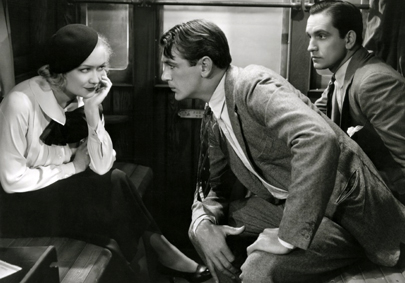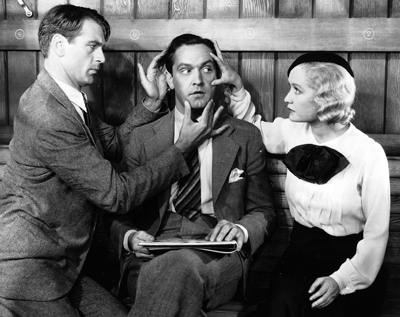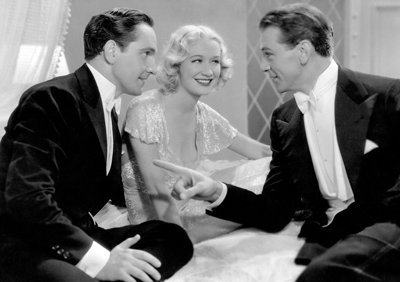
 |
|
|
|
Lovers of Ernst Lubitsch are drawn to his teasing pre-Code musicals and his elegantly playful comedies, written by great talents like Samson Raphaelson and the team of Billy Wilder and Charles Brackett. Whether skirting the censors with clever visual analogs for sex (Trouble in Paradise) or building a mistaken-identity romance for a family audience (The Shop Around the Corner) Lubitsch had a playful way of distilling a situation in one or two potent images. His films have some of the best dialogue of the 1930s, but also display the visual finesse of great silent cinema. 
Lubitsch's most challenging pre-Code provocation is his adaptation, with ace writer Ben Hecht, of Noel Coward's play Design for Living. The play toys with the possibilities of a three-way relationship between two men and a woman. Lubitsch's film is another animal altogether, a concoction that relies more on camera style and directorial finesse than the written word -- Hecht's script uses almost nothing of Coward's witty dialogue. The very first scene places a young woman in a train compartment with two sleeping men. She clearly finds them very attractive. Stretching out to rest, the woman places her feet on the seat between these two. Lubitsch makes note of her legs as one of the napping men absently rests his hand on her shoe. Without a word being spoken, the main theme has been fully expressed. Why should love break up established relationships? What if a woman decided to live with two men, as a companion and facilitator for their ambitions? Could it actually work? Lubitsch doesn't resolve the basic question any more than Coward does, but his film is considered the height of pre-Code sophistication. Penniless in Paris, unpublished playwright Tom Chambers and un-exhibited artist George Curtis (Fredric March & Gary Cooper) aren't getting very far with their respective careers. But their looks attract the daring young Gilda (pronounced "Jill-da") Farrell (Miriam Hopkins). She's an emancipated commercial artist open to new romantic ideas, within reason. Both men go for Gilda and make separate attempts to monopolize her affections. When each is caught trying to elbow the other out, they decide that Gilda is manipulating them, and back off. That doesn't work either. Realizing that the situation calls for creative thinking, Gilda proposes that they live as a threesome. They can enjoy each other's company and Gilda will do her best to help all three of them attain their artistic goals. The one rule is, no sex! Gilda critiques their work until George's paintings and Tom's plays improve. She also turns out to be a skilled artist's manager, and soon has attracted a theatrical producer (Franklin Pangborn) for Tom and gallery space for George. But the improvised three-way romance falters when Tom goes off to London to rehearse a play. He returns to find that his partners have broken their sworn oath by becoming lovers. 
The Noel Coward faithful dismissed both Lubitsch and the movie for daring to use the play's title, bare outline and almost nothing else. Lubitsch and Ben Hecht discard Coward's refined language (Hecht was a rough 'n' tumble veteran of Chicago newspapers) but do a marvelous job of telling the story visually. Tom and George are enraptured at the sight of Gilda pacing back and forth in their grubby walk-up garret. Knowing exactly the effect she is creating, she pauses every so often to fling herself backward onto one of their beds. The place is so unkempt that Gilda raises a cloud of dust every time. The boys don't mind a bit. At the time, Fredric March and Gary Cooper were considered two of the best-looking stars in Hollywood. As critics of the time noted, neither personifies much of an artistic sensibility; Cooper in particular looks as if he should be posing for pictures instead of painting them. Like unimaginative straight men, the 'boys' are continually taken by surprise as they wrestle with their new domestic challenges. Most of the work floating the film's premise falls to Miriam Hopkins. Her Gilda is a manipulator but also a natural multi-tasker in the roles of seductress, mother, muse and lover. A third suitor pursues Gilda through the film, the wealthy advertising man Max Plunkett. Edward Everett Horton plays the humorless Plunkett in a subdued version of his familiar comic persona. Max hovers on the margins, taking pleasure whenever Gilda's relationship with Tom and George falters. To our surprise Gilda eventually marries him. On their wedding night the appallingly un-romantic Max is doing his best to be amorous. He reminds his bride that he has an early business appointment, so they'll need to hurry the evening along. Gilda knows that the marriage is doomed. Billy Wilder struggled throughout his career to concoct filmic moments that would have pleased Ernst Lubitsch, his mentor. The most noted bit of business in Design distills the vaunted "Lubitsch Touch" to its essence. Surrounded by bouquets of wedding flowers, Gilda notices two unimpressive buds stuck in a simple pot. They're from Tom and George, of course. Having second thoughts about marrying Max, Gilda knocks the flowers over. But she shows her true feelings by returning from the bedroom to gently replant them and set the pot upright. Come morning, a frustrated and unhappy Max steps from the bedroom. He sees the plants sitting there on the floor, and kicks them across the room. They have clearly been stand-ins for Gilda's absent beaux. With a couple of simple but unmistakable gestures, Lubitsch has made unnecessary half a scene's worth of theatrical dialogue. 
It goes without saying that in 1932 alternate lifestyles weren't granted full social acceptance. Lubitsch and Hecht's carefree ending sees the trio back together again, but without a new plan for their relationship. Although his play states its theme more directly, Noel Coward couldn't come up with the elusive "design for living" either. It's possible that producer Lubitsch bought the play as an aid to circumventing the Production Code. Although enforcement was lax the censors frequently neutralized "inappropriate" subject matter at the script stage. A property by an important author like Ernest Hemingway or Noel Coward was a powerful negotiating tool for the studio: an outright rejection of respected source material would reveal the censors for what they were, cultural bluenoses. Although the movie has no sex scenes, it's clear that George and Gilda are "living in sin". Depending on how the first act is interpreted, Gilda may have slept with both men. The one character representing conventional morality is portrayed as a clueless fool. Hecht's script makes fun of Max's moral mantra: "Immorality may be fun, but it isn't fun enough to take the place of one hundred percent virtue and three square meals a day." The Production Code office believed that only movies with uplifting themes acknowledging the rightness of society's values should be tolerated. A year later, Design for Living was withdrawn from exhibition and denied a certificate for re-issue, along with other earlier pre-Codes like I'm no Angel, Of Human Bondage and The Story of Temple Drake. Criterion's Blu-ray of Design for Living is a smooth encoding of a good transfer of this under-circulated pre-Code gem. Paramount's elegant and tasteful 'house style' in the early 1930s is reflected in the gleaming sets, and even the artists' Parisian garret looks glamorously impoverished. Criterion enables the viewer to compare the Lubitsch film with Noel Coward's play by including an entire British TV production from 1964, starring Jill Bennett, Daniel Massey and John Wood. Critic and filmmaker Joseph McBride weighs the versions in a new interview. Film scholar William Paul contributes a selected scene commentary that may help Lubitsch newbies better understand the filmmaker's famous "touch". Also offered is The Clerk, a very brief Lubitsch-directed scene from 1932's If I Had a Million, starring Charles Laughton. Criterion's insert booklet features critic Kim Morgan's perceptive essay on Design for Living, that focuses on the show's intriguingly progressive sexual politics.
On a scale of Excellent, Good, Fair, and Poor,
Design for Living Blu-ray rates:
Reviews on the Savant main site have additional credits information and are often updated and annotated with reader input and graphics. Also, don't forget the 2011 Savant Wish List. T'was Ever Thus.
Review Staff | About DVD Talk | Newsletter Subscribe | Join DVD Talk Forum |
| ||||||||||||||||||